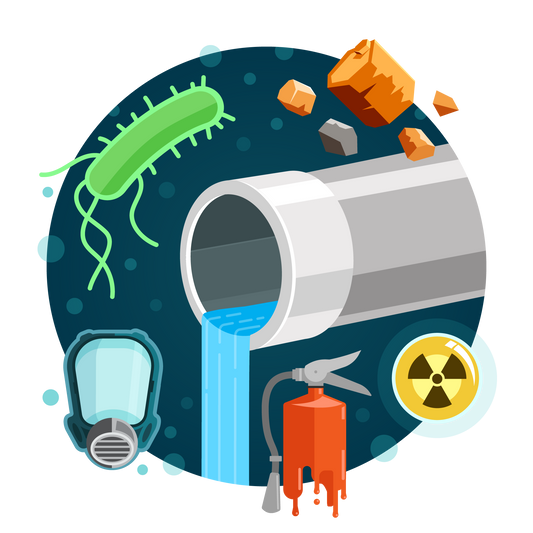
The Ultimate Guide to Heavy Metals in Drinking Water
Our blog is written by real experts— not AI. Each guide is carefully reviewed and updated based on the latest research. Plus, with no affiliate links, you can count on unbiased insights you can trust.
Heavy metals in drinking water can be a hidden risk because many of them cannot be seen, smelled, or tasted. While lead is widely known, there are a number of other metals that can also be harmful that could be in your drinking water. Which ones are most common, and which pose the greatest health risks?
This ultimate guide covers the key heavy metals you should test for, how to detect them, and what steps you can take to remove them from your water. Understanding these contaminants is crucial for protecting your health.
Table of Contents:
- Lead
- Copper
- Arsenic
- Chromium
- Nickel
- Manganese
- Aluminum
- Uranium
- Iron
- Can I Filter Metals from My Drinking Water?
- What’s the Takeaway?
Lead in Drinking Water

Lead—a bluish-silver, naturally occurring metal—is toxic to humans, animals, and most other lifeforms. It can enter your tap water in three ways:
- Primarily, from the corrosion of household pipes, fixtures, solder and service lines
- From the erosion of natural deposits into your water source
- From industrial waste contaminating your water source
-
There is no amount of lead allowed in drinking water. Even low levels of lead exposure can be dangerous, particularly for children. Reducing lead exposure through drinking water is a major priority of the Environmental Protection Agency (EPA). Learn more about EPA regulation and the upcoming Lead and Copper Rule Improvements.
- You cannot see, smell, or taste lead in your drinking water, but the age of your home can be a clue to your risk level. If you live in a house built prior to the 1990s, your property might have a lead service line or lead-containing plumbing fixtures. Having your water tested with a certified laboratory is highly recommended.
- Because lead contamination is largely the result of pipes and fixtures leaching lead into your water, point-of-use (POU) filters are often recommended to filter your drinking water. These include undersink systems and pitcher filters. Always look out for filters that are NSF certified (standards 53 or 58) for the removal of lead.
Ultimate Guide to Lead in Drinking Water
Copper in Drinking Water

Copper is a soft, malleable metal that occurs naturally in various minerals. It is one of the most commonly detected heavy metals in tap water. The most common source of copper in drinking water is the corrosion of copper pipes, faucets, and other plumbing fixtures.
- Small amounts of copper are essential for our health, but too much copper can be harmful. The EPA has set a (non-enforceable) health goal, Maximum Contaminant Level Goal (MCLG), of 1.3 PPM (parts per million) for copper in drinking water. Long term exposure to elevated levels of copper in drinking water can cause kidney and liver damage. Ingesting a very high amount of copper all at once can cause acute effects such as vomiting, diarrhea, and stomach cramps—especially among young children.
- You might be able to detect copper levels > 1 PPM without testing your water because copper can impart a metallic flavor to your water. Additionally, the higher the concentrations climb, the more apparent blue-green stains may be on and around your fixtures. Though these are useful signs, it is still best to get your water tested at a certified laboratory to determine the amount of copper and other contaminants in your water.
- Running your water for a minute before drinking can reduce copper buildup at your tap. POU filters are often suggested to address copper contamination. Make sure they’re NSF certified (standards 53 or 58) for the removal of copper.
Arsenic in Drinking Water

Arsenic is another naturally occurring metal found in the earth's crust that is very toxic to humans. Arsenic typically gets into drinking water two ways:
- By contaminating groundwater sources (like aquifers) through the erosion of arsenic-rich soil and rocks
- As runoff from agriculture or industrial activities
-
The EPA has set a Maximum Contaminant Level (MCL) for arsenic of 10 PPB (parts per billion). However, studies have shown that levels as low as 5 PPB had impacts on children’s development; the EPA set the MCLG for arsenic at 0. Chronic exposure to arsenic in drinking water can cause complications with many different vital organs and organ systems. It is also a known carcinogen, and long term exposure to arsenic in drinking water can increase your risk of cancer.
- You cannot see, smell, or taste arsenic in drinking water. Arsenic is primarily a problem for private well owners who draw their water from underground aquifers. Agricultural and industrial runoff also impacts well water sources. While community water systems are mandated to test for arsenic, private well owners are responsible for their own water quality.
- Testing is the only way to determine whether or not you have arsenic in your water, its concentration, and its specific form. Different oxidation states of arsenic respond to treatment technologies in different ways, so determining the oxidation state of arsenic in your well is crucial for choosing an appropriate treatment.
Arsenic in drinking water can be removed using:
- Reverse osmosis
- Anion exchange
- Adsorptive filter media (including activated alumina and iron-based filters)
Testing before you treat is the only way to be sure your treatment selection will be effective for the specific form(s) of arsenic in your water. Look for NSF standards 53 and/or 58 for the reduction of arsenic when shopping for a filter system.
Ultimate Guide to Arsenic in Drinking Water
Chromium in Drinking Water

Chromium is a metal that occurs naturally in the environment in multiple forms, the most common being chromium III. Different forms of chromium are produced when chromium III is used in manufacturing processes like electroplating. Chromium enters drinking water sources through:
- Erosion of chromium-rich rock
- Runoff or dumping of mining and industrial waste
Chromium in drinking water is typically in one of two forms:
- Trivalent chromium (CrIII), an essential nutrient
- Hexavalent chromium (CrVI), a potent human carcinogen
-
The EPA has set the MCL for total chromium at 100 PPB. Even though hexavalent chromium is the threat, there is no federal or state MCL for hexavalent chromium in particular. Scientists at the California Office of Environmental Health Hazard Assessment (OSHA) recommend a public health goal of 0.02 PPB for hexavalent chromium in drinking water.[1]
- Ingestion of chromium VI is known to cause cancer. Additional health effects of hexavalent chromium in drinking water include damage to the liver and kidneys, and it is also known to cause circulatory disorders and nerve damage.
- Like many metals in drinking water, chromium cannot be seen, tasted or smelled in drinking water. The only way to know if chromium is present in your drinking water is to have it tested by a certified laboratory.
Chromium can be removed from drinking water through reverse osmosis technology. Make sure your device is certified to NSF/ANSI standards 53 or 58.
Nickel in Drinking Water

Nickel typically reaches drinking water sources via mining and smelting activities. Nickel-plated faucets and fixtures can also become a source of contamination.
- There are no EPA-enforced limits on nickel levels in drinking water. Nickel sensitivity is a common issue and skin irritation is the most common effect of exposure to nickel in water through showering or bathing. Nickel ingestion at levels common in drinking water is not considered harmful.
- Like many other metals, nickel cannot be seen, smelled, or tasted in drinking water. Skin irritation after a shower or bath can be a sign that your water contains nickel. Consider testing your water to learn more. Nickel-plated faucets and fixtures should be replaced if anyone in your family suffers from a nickel allergy.
Manganese in Drinking Water

Manganese is a mineral found in rocks, soil, groundwater, and surface water. The principal source of exposure to manganese is from food. When one is also exposed to elevated levels of manganese in drinking water (primarily through private wells), the overall intake of manganese can become an issue.
- There is no enforceable safe level of manganese in drinking water. The US EPA has set a Secondary Maximum Contaminant Level (SMCL) for manganese in drinking water at 0.05 PPM, a non-enforceable limit intended to be protective against aesthetic issues. The EPA recommends manganese in drinking water remain below 1 PPM.[2] You may notice a metallic taste, brownish color, and/or black deposits on fixtures or laundered clothing, and even black slime if your water contains manganese at concentrations > 0.05 PPM.
- While manganese is an essential nutrient required by the human body in small amounts, exposure to high concentrations of manganese over many years has been associated with toxicity to the nervous system, with particular risks to infants.[2]
- Successfully removing manganese from water depends on its oxidation state, the pH of the water, the presence and concentration of other minerals, and the concentration of total dissolved solids (TDS). Testing your water allows you to determine these key factors.
Depending on the results, common solutions may include:
- Oxidizing filters (like manganese greensand)
- Oxidation + filtration
- Catalytic carbon filtration
- Reverse osmosis
Ultimate Guide to Tap Water Color
Aluminum in Drinking Water

Aluminum is a lightweight metal that typically enters water sources through:
- The use of aluminum-based coagulants during water treatment
- Erosion of rocks or soil into water sources
- Runoff from industrial activity into water sources
-
There are no federal regulations in the U.S. that limit aluminum concentrations based on health effects in municipal drinking water. The EPA SMCL for aluminum in drinking water is 0.05-0.2 PPM for aesthetic reasons. Above these levels, water may appear hazy or turn a bluish color. It is difficult to determine an unsafe level of aluminum in drinking water as the exact relationship between aluminum and our bodies is not fully understood.
- Testing your water before you consider treatment options is key to understanding which treatment system is correct for your situation based on the full range of contaminants in your water.
The best methods for filtering aluminum from your drinking water depends largely on your water quality—treatment options include membrane filters like microfiltration or reverse osmosis, depending on your water quality.
Quick Guide to Aluminum in Drinking Water
Uranium in Drinking Water

Uranium is a weakly radioactive heavy metal found naturally in bedrock. It can enter drinking water sources:
- Naturally
- By contaminating groundwater from industrial uses, which include nuclear facilities, certain fertilizers, and photography
Uranium cannot be detected by taste, odor, or color in drinking water. It is weakly radioactive because all of its isotopes (Uranium-234, Uranium-235, and Uranium-238) are unstable. Uranium is regulated under the “Radionuclides Rule.”[8]
The EPA has established an MCL (Maximum Contaminant Level) for uranium in drinking water at 30 PPB. This is in response to human and animal studies indicating kidney toxicity.
NSF states that no water systems are currently certified to reduce uranium, but that products certified to reduce radium under NSF/ANSI 44 and 58 may also reduce uranium.
Iron in Drinking Water

Iron is an abundant metal found naturally in the environment. It typically enters water supplies naturally through groundwater sources. Elevated iron levels in drinking water can also be the result of corroded plumbing. Iron exists in water three states:
- Ferrous ("clear water iron")
- Ferric ("red water iron")
- Organic iron
Iron is known for its reddish-yellow discoloration of water. Tap water may take on a rusty color and metallic taste, contain sediment, or cause reddish orange staining when elevated iron levels are present.
While iron in drinking water is not typically considered harmful to human health, the presence of iron can lead to or indicate other hazards, such as pipe corrosion. Iron does not currently have enforceable limits in drinking water, just a secondary MCL of 0.3 PPM to prevent aesthetic changes.
Water treatment products may earn NSF Certification under the following standards:
- NSF/ANSI 42: Drinking Water Treatment Units - Aesthetic Effects
- NSF/ANSI 61: Drinking Water System Components – Health Effects
Establishes limits on the amount of iron that can leach from plumbing materials into water
How to Remove Metals from Drinking Water
There are a variety of treatment options to remove heavy metals from your drinking water. As you can tell from above, however, testing your water is the only way to understand:
- What metals are in your drinking water
- What state the metals may be in (as with arsenic and chromium)
- Your water’s unique chemistry (like pH levels, TDS levels, etc.)
All of which are key to understanding which treatment system is worth considering. Tap Score tests include easy-to-read and interpret contaminant reports along with treatment recommendations that are specific to your contaminant profile. We recommend the following testing options:
NSF Certification
You also want to be sure that the treatment system you are interested in has been certified by an authorized body (e.g. NSF, WQA, IAPMO) to relevant NSF/ANSI standards. (Some metals—e.g. nickel, aluminum—do not have associated NSF/ANSI standards.)
Does Boiling Water Remove Heavy Metals?
No, boiling water will not remove any of the metals on this list. In fact, if water is boiled for long periods, any metals present can become more concentrated as water is boiled off.
Does Distillation Remove Heavy Metals?
Yes, distillation will remove heavy metals from drinking water. Distillation is a purification process that removes all impurities from water, including beneficial minerals like calcium and magnesium. Distillation is a labor-intensive purification process that requires a lot of resources to produce a relatively small amount of purified water.
What’s the Takeaway?
- Many heavy metals cannot be seen, smelled, or tasted in drinking water
- Lab testing your water is your first step towards protecting yourself against heavy metals
- When considering treatment technologies (after you’ve tested your water), always look out for NSF certifications specific to the metals found in your water when choosing treatment
Read More
▾Lead and Copper Rule Improvements
Ultimate Guide to Lead in Drinking Water
Ultimate Guide to Arsenic in Drinking Water
Ultimate Guide to Tap Water Color
Sources and References
▾- Hexavalent Chromium (Chromium-6) | California State Water Resources Control Board
- Manganese in Drinking Water Fact Sheet & Frequently Asked Questions
- Secondary Drinking Water Standards: Guidance for Nuisance Chemicals | US EPA
- National Primary Drinking Water Regulations | US EPA
- Hexavalent Chromium
- Copper in Drinking Water - MN Dept. of Health
- Metal allergy--a review on exposures, penetration, genetics, prevalence, and clinical implications
- Radionuclides Rule | US EPA











